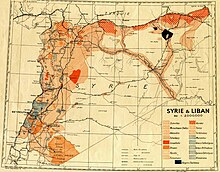Ethnic groups in Syria
Arabsrepresent the major ethnicity inSyria,in addition to the presence of several, much smaller ethnic groups.

Map fromLa cartothèque de l'Ifpo(Institut français du Proche-Orient)
Ethnicity, religion and national/ideological identities
[edit]Ethnicity and religion are intertwined in Syria as in other countries in the region, but there are also nondenominational,supraethnicand suprareligious political identities, likeSyrian nationalism.
Counting the ethnic or religious groups
[edit]Since the 1960 census there has been no counting ofSyriansby religion, and there has never been any official counting by ethnicity or language. In the 1943 and 1953 censuses the various denominations were counted separately, e.g. for every Christian denomination. In 1960Syrian Christianswere counted as a whole butMuslimswere still counted separately betweenSunnisandAlawis.[1][2][3]
Ethnic and religious groups
[edit]The majority of Syrians speakArabicexcept for a minority ofAramaic (Syriac)speakers andKurdishspeakingSyrian Kurds,who altogether form 5-10% of the population.SyrianArabSunni Muslimsform ~70-75% of the populace, Christians altogether around 10%,Alawitesat less than 10%, and the remaining ~5-10% consist of minor ethnoreligious groups including theDruze,Isma'ilis,andTwelver Shiite Muslims.However, these percentages are only indicative.
Arabs
[edit]The majority of Syrian Arabs speak a variety of dialects belonging toLevantine Arabic.Arab tribes and clans ofBedouindescent are mainly concentrated in the governorates ofal-Hasakah,Deir ez-Zor,Raqqaand easternAleppo,forming roughly 20 to 30% of the total population and speaking a dialect related toBedouinandNajdi Arabic. InDeir ez-Zora dialect ofNorth Mesopotamian Arabicis also spoken, reminiscent of that of medievalIraqprior theMongol invasionsin 1258.[4]
- Arab minority groups
- Arab Christians(predominantlyMelkiteOrthodoxandCatholicChristians)
- Druze
- Sunni Muslim and ChristianPalestinians
- Arab Twelver Shias
- Arab Ismailis
Non-Arabs
[edit]Syrian Kurdsform 5 to 10% of the Syrian population, the largest non-Arab minority. Other non-Arabic-speaking Muslim groups includeSyrian Turkmen,who had settled Syria inMamlukandOttomantimes,Syrian CircassiansandSyrian Chechenswho settled in the 19th century, andGreek Muslimswho were resettled in Syria following theGreco-Turkish War of 1897.Assyrians/SyriacsinSyriaform a small minority and mainly speakEastern Aramaicdialects.
- Sunni and AleviTurkmens
- Sunni Circassians
- Sunni Muslim Greeks
- MuslimOssetians[6][7]
- Black people of Yarmouk Basin
- Christian minority groups
- Assyrians/Chaldeans/Syriacs,Eastern Aramaic-speakingpeople
- Armenians
- Italian
- Other groups
- Romani peopleof various creeds
- Mizrahi Jews
- Mandeans
- Arameans (Syriacs)[8][9][10][11][12][13][14][15][16][17]in theAnti-Lebanon mountains.Western Neo-Aramaicis spoken inMaaloulaandJubb'adin.
See also
[edit]- Demographics of Syria
- Languages of Syria
- Religion in Syria
- Sectarianism and minorities in the Syrian Civil War
- Federalization of Syria
References
[edit]- ^Hourani, Albert Habib (1947).Minorities in the Arab World.London: Oxford University Press. pp.76.
- ^(in French)Etienne de Vaumas, "La population de la Syrie",Annales de géographie,Année 1955, Vol. 64, n° 341, p.74
- ^(in French)Mouna Liliane Samman,La population de la Syrie: étude géo-démographique,IRD Editions, Paris, 1978,ISBN9782709905008table p.9
- ^Holes, Clive (2006). Ammon, Ulrich; Dittmar, Norbert; Mattheier, Klaus J.; Trudgill, Peter (eds.)."The Arabian Peninsula and Iraq/Die arabische Halbinsel und der Irak".Sociolinguistics / Soziolinguistik, Part 3.Berlin/New York: Walter de Gruyter: 1937.doi:10.1515/9783110184181.3.9.1930.ISBN978-3-11-019987-1.
- ^"Syrian Alawites, referred to by AKP officials as Nusayris — a derogatory term not accepted by most Alevis in Turkey or Alawites in Syria — indeed can briefly be explained as follows.Some are Turkmen. They speak Turkish(...) "cf. Pinar Tremblay,"Syrian Alawites hope for change in Turkey",Al-Monitor,November 15, 2013
- ^Dzutsati, Valery (2013)."First Ethnic Ossetian Refugees from Syria Arrive in North Ossetia".Eurasia Daily Monitor.10(65).
- ^Izvestia, Yuri Matsarsky (2012)."Syrian Ossetians seek to return to Russia".Russia Beyond.
- ^Abū al-Faraj ʻIshsh.اثرنا في الايقليم السوري(in Arabic). Al-Maṭbaʻah al-Jadīdah. p. 56.
السريان في معلولا وجبعدين ولا يزال الأهلون فيها يتكلمون
- ^iنصر الله، إلياس أنطون.إلياس أنطون نصر الله في معلولا(in Arabic). لينين. p. 45.
... معلولا السريان منذ القديم ، والذين ثبتت سريانيتهم بأدلة كثيرة هم وعين التينة وبخعا وجبعدين فحافظوا على لغتهم وكتبهم أكثر من غيرهم. وكان للقوم في تلك الأيام لهجتان ، لهجة عاميّة وهي الباقية الآن في معلولا وجوارها ( جبعدين وبخعا )...
- ^Rafik Schami (25 July 2011).Märchen aus Malula(in German). Carl Hanser Verlag GmbH & Company KG. p. 151.ISBN9783446239005.
Ich kenne das Dorf nicht, doch gehört habe ich davon. Was ist mit Malula?‹ fragte der festgehaltene Derwisch. >Das letzte Dorf der Aramäer< lachte einer der…
- ^Yaron Matras; Jeanette Sakel (2007).Grammatical Borrowing in Cross-Linguistic Perspective.De Gruyter. p. 185.doi:10.1515/9783110199192.ISBN9783110199192.
The fact that nearly all Arabic loans in Ma'lula originate from the period before the change from the rural dialect to the city dialect of Damascus shows that the contact between the Aramaeans and the Arabs was intimate…
- ^Dr. Emna Labidi (2022).Untersuchungen zum Spracherwerb zweisprachiger Kinder im Aramäerdorf Dschubbadin (Syrien)(in German). LIT. p. 133.ISBN9783643152619.
Aramäer von Ǧubbˁadīn
- ^Prof. Dr. Werner Arnold; P. Behnstedt (1993).Arabisch-aramäische Sprachbeziehungen im Qalamūn (Syrien)(in German). Harassowitz. p. 42.ISBN9783447033268.
Die arabischen Dialekte der Aramäer
- ^Prof. Dr. Werner Arnold; P. Behnstedt (1993).Arabisch-aramäische Sprachbeziehungen im Qalamūn (Syrien)(in German). Harassowitz. p. 5.ISBN9783447033268.
Die Kontakte zwischen den drei Aramäer-dörfern sind nicht besonders stark.
- ^Prof. Dr. Werner Arnold (2006).Lehrbuch des Neuwestaramäischen(in German). Harrassowitz. p. 133.ISBN9783447053136.
Aramäern in Ma'lūla
- ^Prof. Dr. Werner Arnold (2006).Lehrbuch des Neuwestaramäischen(in German). Harrassowitz. p. 15.ISBN9783447053136.
Viele Aramäer arbeiten heute in Damaskus, Beirut oder in den Golfstaaten und verbringen nur die Sommermonate im Dorf.
- ^"Hilfe für das Aramäerdorf Maaloula e.V. | an aid project in Syria".
External links
[edit]- Sectarianism in Syria (Survey Study)
- "Syria".World Directory of Minorities and Indigenous Peoples.Minority Rights Group International.
- "Guide: Syria's diverse minorities".BBC. 2011.

